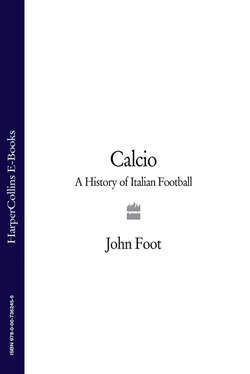Читать книгу Calcio: A History of Italian Football - John Foot - Страница 66
Genoa. On the Margins
ОглавлениеSince 1924, when Genoa won the last of their nine championships, the port city has only won the league title once, with Sampdoria in 1991. Genoa’s best showing in all that time was fourth place in that same year, and they have spent much of their time in Serie B. Sampdoria – only formed from a fusion of two city clubs in 1946 (Andrea Doria and Sampierdarenese) – had their moment of glory in the late 1980s and early 1990s, with a team which relied heavily on the exceptional striking partnership of Roberto Mancini and Gianluca Vialli, and the wily transfer-market dealings of president Paolo Mantovani. Their manager was the hilarious Yugoslav, Vujadin Boskov, celebrated for his surreal comments in basic Italian. When asked about a controversial spot kick, he would invariably reply that: ‘it is a penalty when the referee blows’ (Rigore è quando arbitro fischia) or ‘the team which makes fewer mistakes, wins…we made more mistakes. We lost’. There are now whole books full of Boskovisms. That side came within inches of winning the European Cup in 1992 at Wembley, as Vialli’s misses allowed Barcelona to win with a late goal. Sampdoria also won the Italian Cup four times between 1985 and 1994 as well as the Cup-Winners Cup in 1989. All this success was built on unbreakable squad unity. Seven of the championship team used to hang out together, calling themselves the seven dwarves. Once the championship was secured, the whole team peroxided their hair for the final game.
Once Vialli left, and Mantovani died (in 1993), the team went into a slow decline – although they finished third and won the Italian Cup under the stewardship of Sven Goran Eriksson. In 1998 they ended up in Serie B and only returned to a dignified, mid-table Serie A finish in 2004. Both Vialli and Mancini became successful managers, confirming the analyses that had seen them as ‘on-pitch’ managers in the 1980s and 1990s.
Genoa’s post-war history has been far less glorious. Like Torino, they have never lived up to a past that is now so far away as to be almost completely forgotten. William Garbutt came back for a time after the war but the club hovered between A and B, and never made a serious challenge for the scudetto. Winger Gigi Meroni briefly became a hero for the team in the early 1960s but the team was dogged by doping and corruption scandals. From 1965 to 1972 the club remained out of Serie A altogether and in 1970 they even ended up in Serie C, before tasting the top division briefly thanks to three promotions and the same number of relegations in the 1970s and 1980s. Genoa fans went through hell and humiliation as Sampdoria became a world-class team, and the derby ‘of the Lantern’ was rarely played while Genoa languished in B. Financial problems also hit the club in the 1990s. The only high point in the whole decade was a UEFA Cup-tie victory at Anfield in 1992. Otherwise, Genoa seemed destined to repeat the fate of a number of other ex-big clubs, scrapping for points in Serie B (with sides like Napoli and Torino) and living on distant past glories. Their only real hope lay with an ambitious and rich president, a dream that seemed to have come true with the arrival of toy billionaire Enrico Preziosi in 2004. Yet, once again, the loyalty of Genoa’s fans was tested to the limit as a corruption scandal robbed them of a return to Serie A in 2005. Finally, the 2007 season saw Genoa win promotion to Serie A after nine years in the wilderness. Once again, however, their patron’s role was marked by controversy. As the fans partied in the fountains of the city centre, news came through that Enrico Preziosi was to be banned from football altogether for his role in the bankruptcy of his ex-club, Como.
